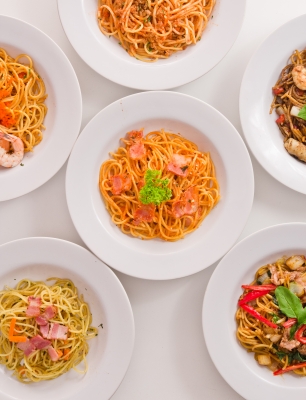Not too long ago, I posted an article about a bottom-less bowl of soup experiment carried out by Brian Wansink and colleagues from Cornell University that demonstrated how we use our eyes to gauge our hunger and satiety levels. Well, here’s another interesting finding about how influential size is on how much we consume from more experiments they conducted using everyday products. Again, you may think you’re immune to this, I know for sure that I am not and I’d even go so far as to say I’m aware of when I’m doing it, and yet, I do it anyway. What about you?
In one experiment, under the guise of a fundraising promotion, they invited parents in to cook dinner for themselves and provided the ingredients: a box of spaghetti, a jar of sauce, and a package of ground beef. Half of the couples that participated were given medium sized packages of foods and half were given large sized packages. What they found was interesting. The couples that prepared dinner with the large packages of ingredients not only prepared 23% more, they ate more.
In another experiment, if they gave people one-pound bags of M&Ms to eat while watching a video, they ate almost twice as many as those that were given half-pound bags. In fact, from all of the foods that they studied, people consistently ate 20-25% more when preparing, serving, or eating directly from larger packages.
This phenomenon wasn’t only restricted to food either. People poured more shampoo, plant fertilizer, dog food, and laundry detergent from large versus small containers. And out of the forty-seven products they tested, all produced the same results except one: liquid bleach. Evidently people are mindful enough to want to prevent ruining their clothes. If only we practiced that much awareness with food to prevent ruining our waistlines!
Now think about how we shop these days. For example, there are so many good reasons to shop at those big box stores, right? They’re convenient for stocking up on groceries and can save you money on the things you’re already buying. But if you’re consuming more than you normally would, you may not be saving money after all.
Think about every product you use. Do you use more paper towels, napkins, or toilet paper when you know you have a plenty stashed away? More aluminum foil, plastic wrap, or Q-tips? Are you pouring a bigger bowl of cereal, squeezing more ketchup onto your plate, or eating larger servings of chips from the family-size bag? Or like me in the past, after getting halfway through a giant box of something, do you throw it away because everyone’s tired of it?
It’s so tempting to think that bigger is better, but this is not always true, especially when it comes to food. So here are some tips to get around over consuming:
If you’re buying in bulk, separate into smaller portions. You may normally do this for foods like meats for freezing, but how about foods like nuts, chips, and cereals? Keep smaller amounts visible for everyday and store the reserves for refilling.
Buy only what you need. Are you tempted to buy larger quantities simply because they cost less per serving? A smaller jar of spaghetti sauce may cost more per ounce than a larger jar, but if the smaller jar is enough to feed the family, then you’ll be saving money and calories simply by consuming less. You’ll also be saving on space.
Serve yourself. Are you in the habit of snacking directly from the big bag of chips or popcorn? If so, you’re more likely to underestimate your portion size and overeat. Instead, serve yourself a portion of food directly into a bowl or plate and walk away from the bag. You’ll be less likely to overindulge.
In the end, it’s all about thinking about your family’s specific shopping and consuming habits and unique needs. And without too much change to your lifestyles, you may be able to save yourself calories, money, space, and just as important, the environment!
If you’re looking for support to help you reach your health goals, contact me for a Weight Loss Breakthrough Session today.

